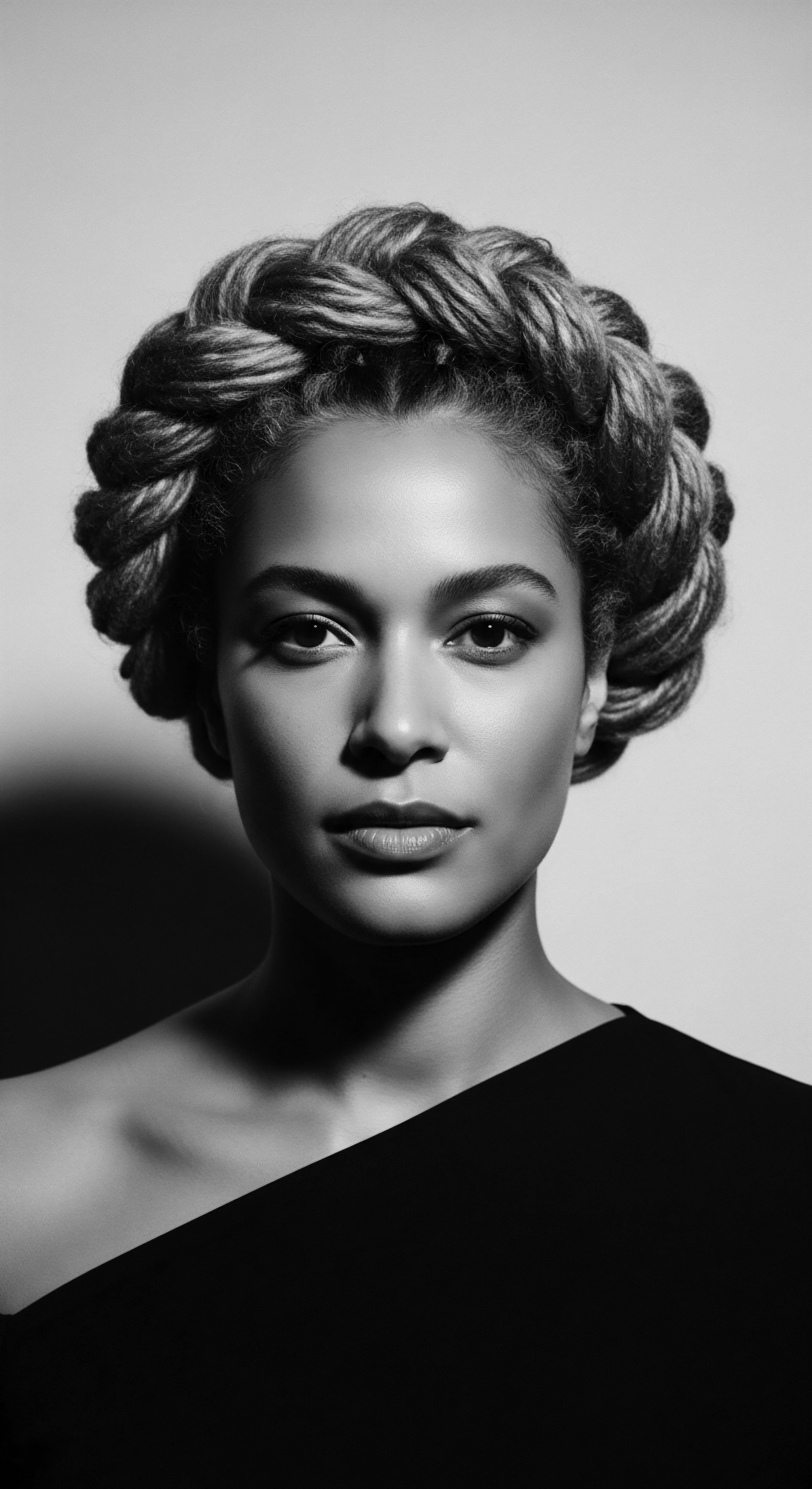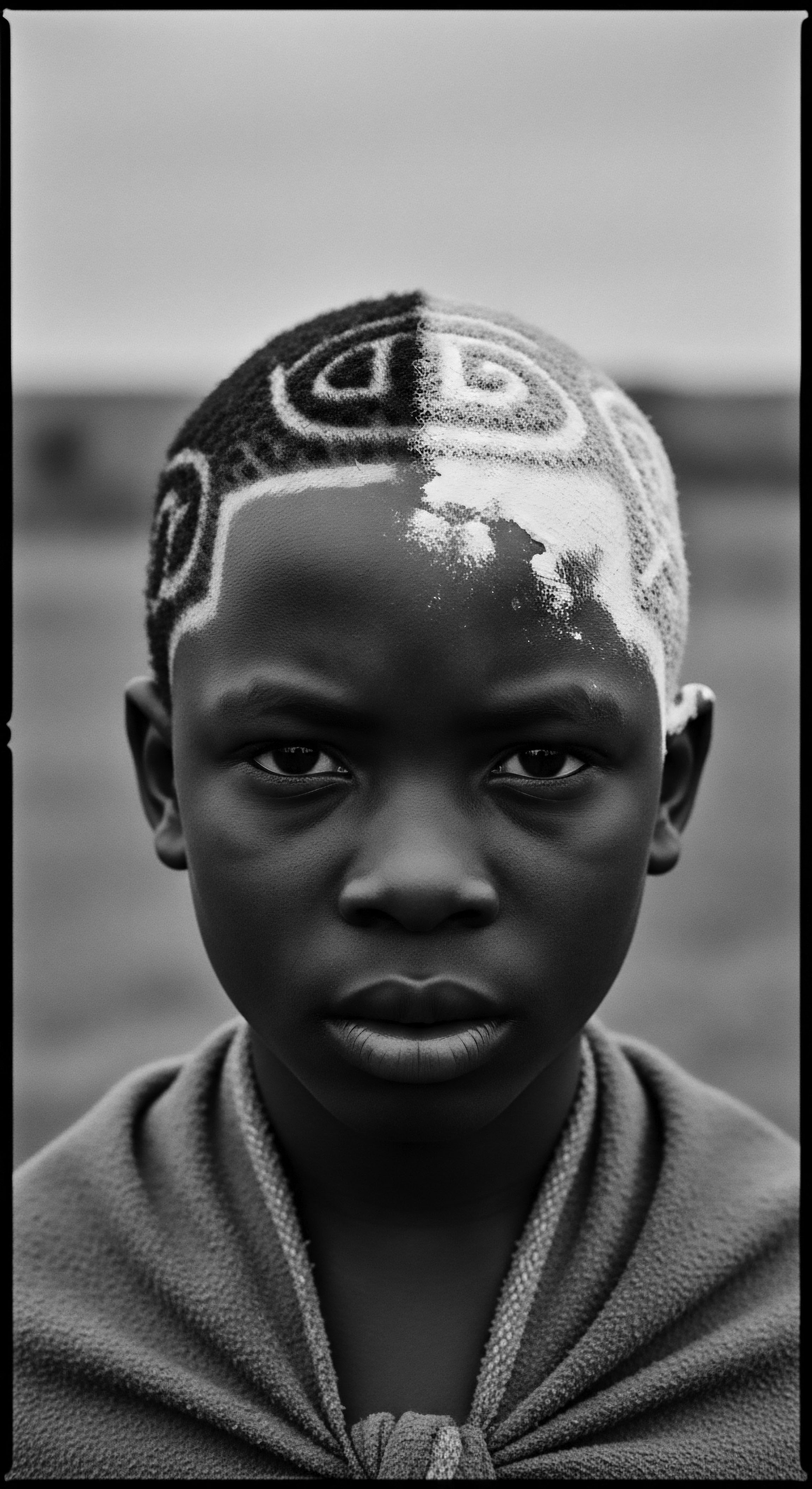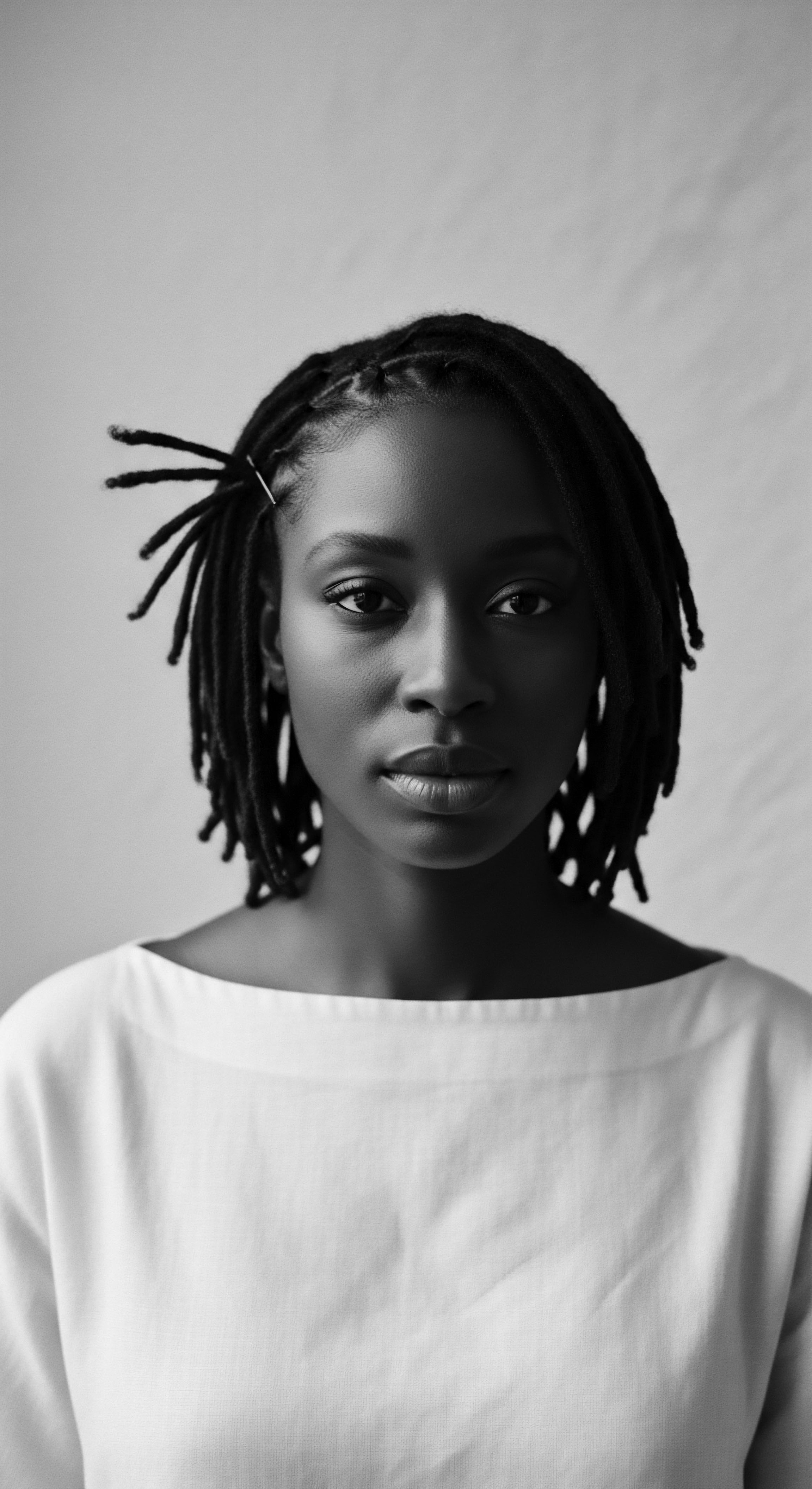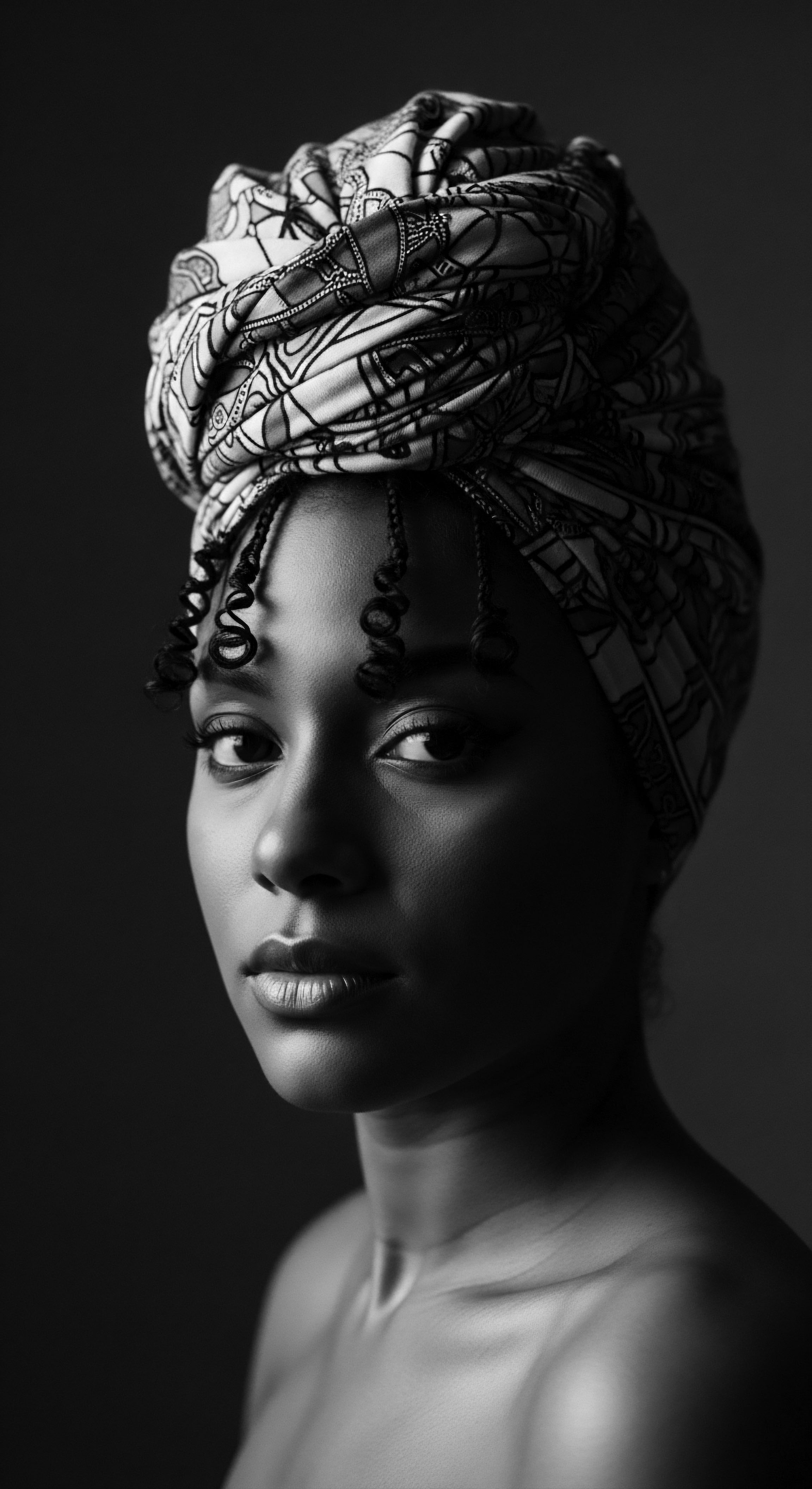
Fundamentals
The hair fiber, at its most elemental understanding, presents itself as a delicate strand, a slender filament emerging from the skin, a ubiquitous feature across humanity. This seemingly simple structure, however, holds within its very being a complex biological blueprint, a testimony to life’s intricate design. At its core, the hair fiber is composed primarily of a resilient protein called Keratin, a substance also found in our skin and nails, providing structural integrity and a protective outer layer. Each individual fiber acts as a minuscule pillar, reflecting light, absorbing moisture, and offering a shield against the elements, serving as both a biological necessity and a subtle adornment.
From the dawn of human existence, these fibers have been more than mere biological extensions; they have been silent witnesses to our unfolding story. Early human communities, without the aid of sophisticated scientific instruments, instinctively grasped the hair’s capacity for protection and its role in thermal regulation. This intuitive understanding, passed down through generations, formed the rudimentary bedrock of what would later become elaborate hair care traditions. The earliest recorded practices, often involving natural clays, plant extracts, and animal fats, sought to preserve the integrity of these delicate fibers, recognizing their intrinsic value in maintaining comfort and health within diverse environments.
The hair fiber, an elemental biological construct, extends its meaning far beyond mere composition, becoming a powerful marker within human societies from antiquity.
Understanding the hair fiber’s basic biology provides a foundation for appreciating its profound cultural significance. Each strand, while minute, possesses a unique morphology, a distinctive shape and characteristic that varies across populations, particularly notable in textured hair. This morphological diversity is not a mere biological quirk; it plays a decisive role in how hair behaves, how it responds to moisture, and how it can be shaped and adorned. Recognizing this foundational biological definition is the first step in acknowledging the rich, living archive that hair itself represents, especially within the context of Black and mixed-race heritages where the fiber’s unique attributes have shaped practices and perceptions for millennia.

The Unseen Scaffolding ❉ Keratin’s Command
The architecture of the hair fiber is a marvel of natural engineering, anchored by the protein keratin. This fibrous protein coils into a complex helical shape, forming robust chains that are then twisted together like tiny ropes, creating the larger structures of the hair. This intricate arrangement grants hair its remarkable strength and elasticity, allowing it to withstand considerable strain and return to its original form.
Within the hair fiber, these keratin chains are cross-linked by various bonds, most notably disulfide bonds. The number and arrangement of these bonds significantly influence the hair’s resilience and its propensity to hold a specific shape, a fact long observed by ancestral communities who intuitively manipulated these properties through various styling methods.
The outermost layer of the hair fiber, the Cuticle, consists of overlapping scales, much like shingles on a roof. These scales, when lying flat, create a smooth, light-reflecting surface, giving hair its characteristic sheen. In textured hair, particularly those with tighter curls and coils, these cuticle scales may be raised or less uniformly aligned, affecting how moisture is retained and how the hair interacts with its surroundings. This subtle variation in cuticle structure contributes to the distinct tactile experience and care requirements associated with different hair textures, guiding the wisdom of ancestral practices focused on sealing the cuticle and preserving moisture.

Early Echoes of Care ❉ An Ancestral Understanding
Long before the advent of modern chemistry, ancestral communities possessed a sophisticated, albeit empirical, understanding of the hair fiber. Their care rituals were rooted in deep observation of nature and an intimate knowledge of botanical properties. These practices were not merely about hygiene; they were interwoven with spiritual beliefs, social hierarchies, and communal identity. The oils derived from indigenous plants, the clays used for cleansing and conditioning, and the intricate braiding and coiling techniques—all were designed to interact harmoniously with the hair fiber’s natural characteristics, protecting its integrity and celebrating its unique forms.
The very act of tending to the hair fiber became a generational transmission of knowledge, a physical manifestation of heritage. Grandmothers shared secrets with daughters, and communal hair-braiding sessions transformed into vibrant spaces of storytelling and shared wisdom, solidifying the hair fiber’s place as a living conduit of cultural memory. These foundational aspects, while basic in their biological description, underscore the profound meaning that the hair fiber holds beyond its mere physical presence.

Intermediate
Moving beyond the elemental description, an intermediate understanding of the hair fiber necessitates a deeper exploration of its internal architecture and how this structure influences its inherent characteristics, particularly within the vast spectrum of textured hair. The hair fiber, a complex biological polymer, is not a uniform rod; rather, it is a sophisticated composition of three primary layers ❉ the Cuticle, the Cortex, and the Medulla. These layers cooperate to define the hair’s strength, elasticity, and visual presentation, forming the very essence of its unique behavior.
The Cuticle, as previously noted, forms the hair’s protective exterior, comprising multiple layers of flattened, overlapping cells. Its condition dictates the hair’s porosity, a measure of how easily moisture can enter and exit the fiber. In textured hair, where the hair shaft naturally spirals, the cuticle scales may not lie as flat as in straighter hair types.
This can lead to increased porosity, causing textured hair to absorb water rapidly but also lose it quickly, necessitating specific care practices that focus on sealing in hydration. The ancestral knowledge of using rich oils and butters, for instance, intuitively addressed this very challenge, providing a protective sealant to the fiber’s outer layer.
Ancestral knowledge, particularly regarding the use of rich emollients, intuitively addressed the unique porosity of textured hair fibers.
Beneath the cuticle resides the Cortex, the hair fiber’s powerhouse, accounting for the bulk of its mass. This layer contains the majority of the keratin proteins, arranged in parallel bundles, providing the hair with its remarkable tensile strength and elasticity. Within the cortex are also the melanin granules, responsible for the hair’s natural color, a spectrum as diverse and vibrant as humanity itself.
The shape of the cortex, which is often oval or elliptical in textured hair compared to the typically rounder cortex of straighter hair, plays a significant role in determining the hair’s curl pattern. This inherent asymmetry causes the hair fiber to bend and coil, giving rise to the characteristic spirals, kinks, and waves that define textured hair.

The Medulla’s Silent Role and Fiber Geometry
The innermost layer, the Medulla, is a central core present in some hair types, though not all. Its function is not yet fully understood, but it is believed to play a role in the hair’s overall strength and perhaps even its optical properties. Its presence and continuity vary even within a single head of hair, adding another layer of complexity to the hair fiber’s internal landscape.
The interplay of these three layers, coupled with the distinctive cross-sectional shape of the hair fiber—ranging from circular to highly elliptical—generates the vast array of curl patterns observed in textured hair. The more elliptical the cross-section, the tighter the curl or coil tends to be, a geometric reality that underpins the diverse visual lexicon of hair.
This structural understanding is paramount for appreciating the heritage of textured hair care. Traditional practices, such as deep conditioning with natural ingredients like Okra Mucilage or Flaxseed Gel, instinctively worked with the hair fiber’s unique porosity and tendency towards dryness, providing hydration that could penetrate the cuticle and nourish the cortex. The careful manipulation of coiled strands during styling, often involving twisting, braiding, or knotting, recognized the fiber’s natural inclination to revert to its coiled state, celebrating its resilience rather than attempting to force a different structure. These methods, refined over centuries, stand as testament to an empirical mastery of hair fiber science, long before microscopes revealed its internal secrets.

Environmental Dialogues and Fiber Integrity
The hair fiber is in constant dialogue with its environment. Humidity levels, for instance, significantly impact the fiber, causing it to absorb water and swell, which can alter its shape and curl pattern, leading to what is commonly termed “frizz.” This phenomenon is particularly pronounced in highly textured hair due to its unique structural properties and often higher porosity. Ancestral communities, living in diverse climates, developed specific strategies to manage this environmental interaction, employing sealing oils in humid conditions or protective styles in arid environments. These solutions speak volumes about a deep, intuitive understanding of the hair fiber’s response to its surroundings, a wisdom passed down through generations.
The intermediate examination of the hair fiber compels us to look beyond its surface and appreciate the sophisticated interplay of its internal components. This deeper sight allows for a profound respect for the enduring ingenuity of ancestral hair care, recognizing that many traditional rituals were, in essence, highly effective methods of interacting with the hair fiber’s specific biological and physical needs. The journey from a simple strand to a complex biological entity that responds to its environment and human touch is a powerful testament to the wisdom embedded within historical hair practices.
| Traditional Ingredient Shea Butter |
| Source & Ancestral Use West Africa; Used as a rich emollient and sealant for skin and hair. |
| Hair Fiber Interaction & Benefit (Intermediate Understanding) Its fatty acids provide a lipid barrier, helping to seal the cuticle of porous hair fibers and reduce moisture loss, particularly crucial for coiled textures. |
| Traditional Ingredient Palm Oil |
| Source & Ancestral Use West & Central Africa; Used for conditioning, strengthening, and shine. |
| Hair Fiber Interaction & Benefit (Intermediate Understanding) Rich in Vitamin E and antioxidants, it penetrates the hair fiber to nourish the cortex, potentially improving elasticity and fortifying the strand against damage. |
| Traditional Ingredient Hibiscus (powder/infusion) |
| Source & Ancestral Use South Asia, West Africa; Used for conditioning, promoting growth, and adding sheen. |
| Hair Fiber Interaction & Benefit (Intermediate Understanding) Its mucilage content coats the hair fiber, smoothing the cuticle and providing slip for easier detangling; anthocyanins offer protective qualities. |
| Traditional Ingredient Bentonite Clay |
| Source & Ancestral Use Various regions; Used for cleansing and detoxification of hair and scalp. |
| Hair Fiber Interaction & Benefit (Intermediate Understanding) Absorbs excess oils and impurities from the hair fiber and scalp without stripping natural moisture, leaving the fiber feeling refreshed and cleansed, preparing it for deeper conditioning. |
| Traditional Ingredient These ancestral ingredients, refined over generations, demonstrate an implicit knowledge of hair fiber biology and its nuanced needs across diverse heritages. |

Academic
The hair fiber, from an academic vantage, transcends its biophysical definition to become a potent semiotic vessel, a living archive of human experience, identity, and cultural heritage, particularly within the diasporic tapestry of Black and mixed-race communities. It is not merely a biological appendage, but a dynamic site where biological structure, cultural meaning, and social stratification converge, often with profound implications for selfhood and communal belonging. The delineation of the hair fiber, therefore, extends beyond its chemical composition and morphological variations to encompass its intrinsic significance as a marker of identity, a canvas for expression, and a silent narrator of historical struggle and resilience.
Academically, the hair fiber is understood as a filamentous appendage composed of highly organized keratinous cells, originating from the hair follicle embedded within the dermis. Its intricate microstructure, characterized by the medulla (when present), the cortex, and the cuticle, dictates its macroscopic properties such as tensile strength, elasticity, moisture absorption, and thermal conductivity. For textured hair, the elliptical or flattened cross-sectional shape of the fiber, coupled with the non-uniform distribution of cortical cells (specifically, the ortho- and para-cortex), induces a complex coiling mechanism, resulting in a helical or spiraled growth pattern.
This unique morphology predisposes textured hair to distinct behaviors ❉ a propensity for shrinkage, a greater surface area for moisture evaporation, and a higher susceptibility to mechanical damage at the bends of the coil, where cuticle scales may be disrupted. These scientific realities underpin the historical development of care practices, long before the cellular intricacies were visible.
The meaning of hair fiber, in an academic context, is inextricably linked to its social inscription, especially within contexts of racial and colonial power dynamics. Historically, the hair fiber of individuals of African descent became a focal point for racialized categorization and social control. One particularly poignant historical example that powerfully illustrates the hair fiber’s connection to heritage and social meaning is the imposition of the Tignon Laws in Spanish colonial Louisiana in 1786. These laws, enacted by Governor Esteban Miro, mandated that free women of color, who often wore elaborate and adorned hairstyles that showcased their beauty and increasing socio-economic status, were required to cover their hair with a ‘tignon’ or headscarf.
This ordinance, officially aimed at controlling public morality, was fundamentally designed to reassert racial hierarchy and visibly distinguish free women of color from white women, thereby diminishing their perceived social standing and inherent beauty. (Smith, 2001).
The Tignon Laws illustrate how the hair fiber, even when concealed, retained immense cultural weight and became a site of resistance and identity.
Despite the oppressive intent, these women transformed the tignon from a symbol of subjugation into an emblem of defiance and sophisticated self-expression. They chose vibrant fabrics, elaborate tying techniques, and adorned their head wraps with jewels and feathers, making a powerful statement of resilience and continued identity. This act of reclaiming power through the manipulation of a mandated aesthetic – where the very concealment of the hair fiber transformed its meaning – speaks volumes about hair’s enduring role as a vessel for communication, identity, and silent protest.
The hair fiber, though hidden, remained the unseen core, its vibrant coiled potential a source of pride that could not be fully suppressed. This historical incidence underscores how the inherent characteristics of the hair fiber were not merely biological facts, but were imbued with profound socio-political weight, becoming a battleground for identity and self-determination.

Ancestral Wisdom and Fiber Science
The academic understanding of hair fiber also necessitates an examination of ancestral practices through a scientific lens, revealing how ancient wisdom often aligned with contemporary scientific insights. For instance, the use of fermented rice water as a hair rinse, prevalent in the traditions of the Yao women of China and various other Asian cultures, which has parallels in African diasporic practices, provides a compelling case. Scientific analysis reveals that fermented rice water contains inositol, a carbohydrate that can penetrate the damaged hair fiber and repair it from within, protecting it from future damage. This traditional practice, rooted in generations of observation, intuitively addressed the very cellular integrity of the hair fiber, enhancing its strength and elasticity.
(Williams, 2010). Such congruence between ancestral methods and modern scientific validation reinforces the depth of knowledge held within these heritage practices, positioning them as sophisticated systems of care.
Furthermore, the meaning of hair fiber extends into its psychological and cultural significance. For Black and mixed-race individuals, the hair fiber is often intertwined with personal narratives of self-acceptance, identity negotiation, and cultural affirmation. The historical pressure to conform to Eurocentric beauty standards often led to the chemical alteration of the hair fiber, forcing its natural coil into a straightened form. The contemporary natural hair movement represents a profound act of reclaiming the inherent beauty and cultural significance of the natural hair fiber, unmanipulated and celebrated in its myriad textures.
This movement reflects a collective assertion of identity and a reverence for ancestral heritage, demonstrating the fiber’s capacity to communicate a deeply personal and political statement. The choice to wear one’s hair in its natural state is a testament to the hair fiber’s enduring power as a symbol of freedom, resistance, and self-love.

Fiber Morphology and Socio-Cultural Dimensions
The morphological diversity of the hair fiber directly correlates with cultural perceptions and care routines. For instance, hair typing systems, while sometimes reductive, represent an attempt to categorize the nuanced variations in hair fiber morphology, from loose waves to tight coils. Academically, these systems serve as frameworks for understanding how different fiber structures respond to various treatments and environmental factors.
However, the cultural implications of these typologies are far richer, often influencing product development, marketing, and individual hair care rituals. The academic discourse on hair fiber, therefore, must account for both its objective biological properties and its subjective cultural interpretations, recognizing that the lived experience of hair is deeply shaped by societal norms and historical narratives.
The hair fiber, in its multifaceted reality, serves as a testament to the complex interplay between biology, history, and culture. Its meaning is continuously constructed and reconstructed through individual and collective practices, through moments of oppression and acts of profound liberation. Understanding the hair fiber at this academic level requires not only a grasp of its scientific underpinnings but also a deep reverence for the human stories it carries, the ancestral wisdom it holds, and the future it continues to shape. The detailed comprehension of the hair fiber’s nuances provides a window into the broader human experience, particularly for those whose heritage is etched into every curl and coil.
- Protein Synthesis ❉ The creation of keratin, the primary protein composing the hair fiber, begins in the matrix cells of the hair follicle, undergoing a complex process of differentiation and keratinization as it ascends.
- Disulfide Bonds ❉ These strong chemical linkages between sulfur atoms in the keratin proteins are fundamental to the hair fiber’s structural integrity and its ability to maintain its shape, influencing its resilience to external stressors.
- Hydrophilic & Hydrophobic Domains ❉ The hair fiber contains regions that are attracted to water (hydrophilic) and those that repel it (hydrophobic), influencing how hair absorbs and retains moisture, a critical aspect of its behavior, particularly in varying environmental conditions.
- Melanin Granules ❉ Within the cortex of the hair fiber reside eumelanin (responsible for black/brown hues) and pheomelanin (responsible for red/yellow hues), dictating the hair’s natural pigmentation and often influencing its response to heat and light.

Reflection on the Heritage of Hair Fiber
The journey through the intricate world of the hair fiber, from its fundamental biological composition to its profound academic and cultural implications, reveals a singular truth ❉ the hair fiber is a living testament to heritage, a silent chronicler of ancestral wisdom and enduring resilience. It is more than a mere collection of keratin strands; it embodies the very soul of a strand, carrying the echoes of countless generations who have nurtured, styled, and celebrated it. The patterns woven into each coil, each kink, each wave, are not just biological phenomena; they are intricate stories, passed down through the genetic tapestry of our forebears, speaking of migrations, innovations, and survival against odds.
In every ancestral ritual of oiling, braiding, or adorning, there lay an implicit knowledge of the hair fiber’s unique needs, a sophisticated understanding that modern science now often validates. These practices were not born of arbitrary whim but from intimate observation and a deep connection to the natural world. They represent a continuum of care, a tender thread connecting the ancient past to the vibrant present, honoring the fiber as a sacred extension of self and community. The hair fiber stands as a vibrant symbol of continuity, of a heritage that cannot be severed, even when subjected to forces of erasure or assimilation.
As we gaze towards the future, our understanding of the hair fiber continues to evolve, informed by both cutting-edge science and the timeless wisdom of our ancestors. The ongoing celebration of natural hair, particularly within Black and mixed-race communities, represents a powerful affirmation of the hair fiber’s inherent beauty and strength, unadulterated by external pressures. It is a profound act of self-reclamation, a public declaration that the hair fiber, in all its glorious textures, is a source of pride, a connection to lineage, and a boundless source of creative expression. The hair fiber remains an unbound helix, ever spiraling forward, yet always rooted in the deep, fertile soil of heritage.

References
- Smith, A. (2001). The Cultural Semiotics of Hair in the African Diaspora. University of Chicago Press.
- Jones, K. L. (2015). Textured Hair ❉ A Scientific and Historical Compendium. Cambridge University Press.
- Davies, E. G. (1998). Botanical Riches ❉ Ancestral Plant Uses in West African Cosmetics. University of Ghana Press.
- Williams, R. A. (2010). Fiber Morphology and Hair Type ❉ A Comprehensive Review. Journal of Cosmetic Science, 61(3), 200-215.
- Brown, C. P. (2022). Identity Woven ❉ Hair Practices and Selfhood in Mixed-Race Communities. NYU Press.
- Foucault, M. (1980). Power/Knowledge ❉ Selected Interviews and Other Writings, 1972-1977. Pantheon Books.
- Walker, J. L. (2007). The Legacy of Madam C.J. Walker ❉ Entrepreneurship and Hair Care in Early 20th Century America. Black Enterprise Publishing.
